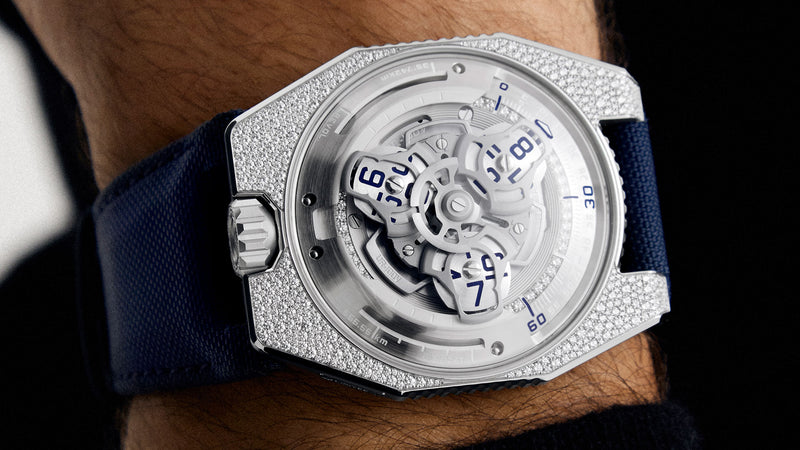

Genus Explores Metal Artisanship with the GNS in Damascene Titanium
After introducing a new way of looking at and telling time with orbital hours and minutes, which garnered the Mechanical Exception Prize at the 2019 Grand Prix d’Horlogerie de Genève (GPHG), Genus explores the world of metal artisanship.
The Genus GNS1.2 TD is carved from a block of Damascene Titanium, the work of expert metalsmithing. Thus, the complex representation of time in flux belonging to Genus finds itself echoed by the moiré, undulating, changing appearance where color nuances make each piece unique by the very nature of this craft. A fusion of ancestral technique and modern material, an association between creator and wearer – Genus takes an approach to watchmaking that truly defies the conventional.
In 2019, Genus opened the first chapter of its story with two remarkable timepieces, the GNS1.2 WG and the GNS1.2 RG. A decade of research, two inventions and three years of development went into these watches. Two patents lay down the basic principles of the innovative mechanism that underpin the watch’s free-flowing time display. It is a movement characterized, first and foremost, by its novel complication for indicating time. No dial, no hands. Genus quite simply invented an unprecedented way of telling time – the mechanism as dramatic performance.
The innovation behind this display complication and its underlying mechanism was imagined, technically, in a completely new and daring way. A new stone humbly brought to the edifice of Swiss horological heritage by the man who invented it, the master watchmaker, Sébastien Billières. An approach first rewarded by the recognition of his peers by the attribution of the prestigious and coveted Mechanical Exception Prize at the Grand Prix d’Horlogerie de Genève (GPHG) in 2019.
Twelve satellites, one for each hour. They make a complete revolution along the periphery of the movement, at the crystal’s edge, once every 12 hours. The fixed white arrow on the left, in front of which the satellites scroll, points to the current hour. To remain in the reading direction, the satellites reorient themselves and pivot 90 degrees every three hours. The hour numbers – molded in Super-LumiNova and affixed to the revolving time-indicating satellites – are the result of meticulous development and design.
After white gold and rose gold, Genus ventures into new territory for watchmaking with a damascened titanium case, hence the name GNS1.2 TD (Titane Damassé). Applying the Damascus smithing technique to titanium requires a rare savoir-faire. In fact, the skill is listed in the Inventory of Intangible Cultural Heritage in France. It is craftsmanship elevated to art, true artisanship, the domain of only the best metalsmiths. It has similarities with the working method of Mokume-gane in Japan, where the method has been used for making katana sword blades since the early 17th century.
Folds Within Folds
The art of damascening consists of forging sheets of metal layer by layer. After having been hammered, each sheet is folded back upon itself, and the operation is repeated as many times as necessary – one might say like preparing the laminated dough used for puff pastry. This homogeneous ‘stacking’ of homogeneous layers, each one annealed between each fold, gives the material an entirely new, very particular aspect. Each incision, each bevel into the edge of the damascened metal reveals the strata, the shapes, the undulations, the unique character of each layer.
The difficult work, at the heart of the forge's embers, of folding and layering is usually done with iron or steel for katana blades. Although 40% lighter, titanium is three times harder and can be forged at temperatures 300 degrees higher than for conventional watchmaking steel. This makes the method, which remains largely manual, quite laborious, and complex. In addition, to further enrich the appearance of this basic material, Genus works with layers of various titanium alloys, each of which exhibits a different tint and reaction to heat. The colorful effect is rendered even more visually arresting by the final heat treatment that determines the general tone of the metal block, along with its subtle differences in tints and hues.
Bespoke Colors and Contrasts
Each part of the GNS1.2 TD’s casing is cut at an angle to achieve a different, unique appearance. Genus then works to coordinate the different parts that make up a watch. Here, the intimate relationship between Genus and the wearer again comes into play. Indeed, the future owner is invited to attend the ‘damascene revelation’ by open flame at the Genus workshop in Geneva and will be able to intervene directly in the coloring as well as decide on a particular surface finish: matte, satin or polished. Only the owner shall be privy to the secrets of the manufacturing process and the artisans' skills.
A Movement Preserved
At the core of the GNS1.2 TD, the same heart, the same brain as in the GNS1.2 WG – the 18-karat gold in-house caliber that was awarded the Mechanical Exception Prize at the Grand Prix d’Horlogerie de Genève (GPHG) in 2019.
Creativity, innovation, singularity being the intrinsic values of Genus, the caliber 160W-1.2 forms the natural foundation of this authentic, genuine, and sincere watchmaking approach.
Particularly attentive to its customers, and always receptive to their wishes and preferences, Genus has made several adjustments to its masterpiece. For instance, the orientation of the ‘genera’ – the hallmark free-moving elements that flow in a pattern to indicate the tens-of-minutes – can now be personalized. They can be set straight or inclined, depending on the wearer's aesthetic preference for the watch. This option can provide a more comfortable legibility for some owners.
In addition, Genus adjusted the curvature of the sapphire crystal which eliminated the perceived ridges on the upper perimeter. This mitigates any visual distortion of the hour indices, thereby improving clarity of the timekeeping mechanism.

















0 comments